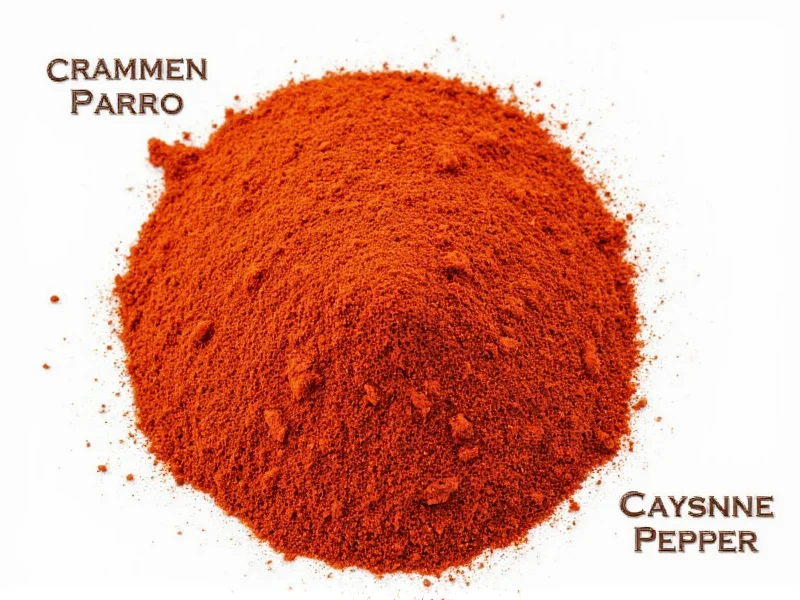Understanding the distinction between crushed red pepper and cayenne pepper is essential for home cooks and professional chefs alike. Despite frequent confusion in grocery stores and recipes, these two pantry staples serve different culinary purposes due to their composition, heat profiles, and flavor characteristics.
Composition and Ingredients
Crushed red pepper, often labeled as "red pepper flakes" in stores, typically contains a mixture of dried chili peppers. Most commercial blends include varying proportions of cayenne peppers along with other varieties like bell peppers, ancho, or jalapeño. This blend creates a more complex flavor profile with moderate heat.
Cayenne pepper, by contrast, is made exclusively from ground cayenne peppers. This single-ingredient composition delivers consistent, intense heat without the nuanced flavor variations found in crushed red pepper blends. When examining spice labels, authentic cayenne should list only "cayenne pepper" as its ingredient.
Heat Level Comparison
The heat difference between these spices represents their most significant distinction. Cayenne pepper measures between 30,000-50,000 Scoville Heat Units (SHU), placing it firmly in the medium-hot category. Crushed red pepper typically ranges from 500-2,000 SHU, making it substantially milder.
| Characteristic | Crushed Red Pepper | Cayenne Pepper |
|---|---|---|
| Primary Ingredients | Mixture of dried chili varieties | 100% ground cayenne peppers |
| Heat Level (SHU) | 500-2,000 | 30,000-50,000 |
| Flavor Profile | Earthy, slightly smoky, complex | Sharp, intense, straightforward heat |
| Texture | Flaky, irregular pieces | Fine, consistent powder |
| Common Culinary Uses | Pizza, pasta, Mediterranean dishes | Cajun cuisine, hot sauces, spice blends |
Culinary Applications and Substitution Guidance
When considering crushed red pepper vs cayenne pepper in cooking, understanding their appropriate applications prevents recipe disasters. Crushed red pepper works best when you want visible spice flakes and moderate heat that complements rather than dominates a dish. It's ideal for finishing pizzas, sprinkling on pasta, or adding to Mediterranean recipes where visual texture matters.
Cayenne pepper shines when consistent, intense heat is required throughout a dish. Its fine powder blends seamlessly into sauces, marinades, and spice rubs. Professional chefs often prefer cayenne for recipes requiring uniform heat distribution.
Substituting between these spices requires careful consideration. If replacing crushed red pepper with cayenne, use only 1/8 to 1/4 teaspoon of cayenne for every teaspoon of crushed red pepper. Conversely, when substituting crushed red pepper for cayenne, you'll need approximately 4-8 times more to achieve similar heat levels, though this will alter the dish's texture and flavor complexity.
Storage Recommendations
Both spices maintain optimal flavor and potency for 1-2 years when stored properly. Keep them in airtight containers away from light, heat, and moisture. The refrigerator provides ideal storage conditions, though a cool, dark pantry works acceptably. Avoid storing near stovetops or ovens where temperature fluctuations degrade quality.
Common Misconceptions Clarified
Many home cooks mistakenly believe crushed red pepper and cayenne pepper are identical. This confusion often stems from similar packaging and labeling practices. Some brands market their crushed red pepper as "cayenne flakes," further muddying the waters. Understanding the difference between crushed red pepper and cayenne pepper prevents recipe failures and ensures proper heat levels.
Another prevalent misconception involves substitution ratios. Many online sources suggest a 1:1 substitution, which typically results in overly spicy or insufficiently seasoned dishes. The actual substitution ratio depends on the specific crushed red pepper blend's composition, as some contain higher proportions of cayenne than others.
Practical Usage Tips
For authentic Italian dishes, crushed red pepper provides the traditional texture and moderate heat profile. When making hot sauces or Cajun/Creole recipes, cayenne delivers the consistent, intense heat these cuisines require. When experimenting with the difference between crushed red pepper and cayenne in your cooking, start with smaller amounts than you think necessary—you can always add more heat, but you can't remove it once added.
Frequently Asked Questions
Can I substitute crushed red pepper for cayenne in recipes?
Yes, but with significant adjustments. Use 4-8 times more crushed red pepper to match cayenne's heat level, though this will alter texture. For precise substitution, start with 1 teaspoon crushed red pepper for every 1/8 teaspoon cayenne, then adjust to taste.
Why is cayenne pepper hotter than crushed red pepper?
Cayenne pepper contains only the hottest parts of cayenne peppers, while crushed red pepper blends typically include milder chili varieties. The concentrated capsaicin in pure cayenne creates its significantly higher Scoville rating (30,000-50,000 vs 500-2,000).
What's the difference between red pepper flakes and cayenne?
Red pepper flakes is another name for crushed red pepper—a blend of dried chili varieties. Cayenne refers specifically to ground cayenne peppers. The key difference between red pepper flakes and cayenne lies in composition (blend vs single ingredient) and heat intensity.
Which is healthier, crushed red pepper or cayenne?
Both contain capsaicin with similar health benefits, but cayenne delivers more concentrated amounts due to its higher heat level. Neither has significant nutritional differences beyond their capsaicin content, which may support metabolism and circulation when consumed in moderation.
How much cayenne equals one teaspoon of crushed red pepper?
Approximately 1/8 to 1/4 teaspoon of cayenne equals one teaspoon of crushed red pepper in terms of heat level. Always add cayenne gradually and taste as you go, as the exact ratio depends on the specific crushed red pepper blend's composition.











 浙公网安备
33010002000092号
浙公网安备
33010002000092号 浙B2-20120091-4
浙B2-20120091-4